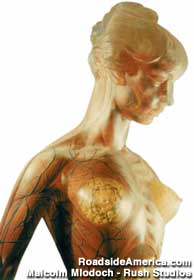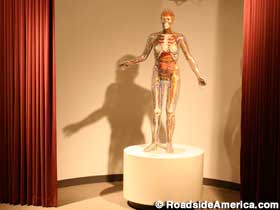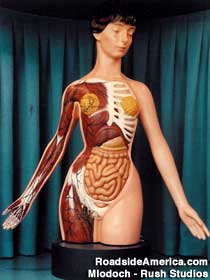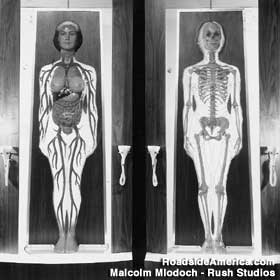
Transparent Anatomical Mannikin (TAM).
Transparent Women
Anyone who thinks men are transparent should visit the nation's health education museums. That's where you can find transparent women, life-size see-through models used to explain anatomy and the mysteries of life to generations of school children.
The first transparent women, a companion to the Transparent Man, was made by craftsmen in the German Hygiene Museum in 1930, and first appeared in the US in 1936, at the New York Museum of Science. According to a 1936 account in Time Magazine, the life-sized glassy woman was equipped with 20 pairs of lamps to selectively illuminate organs sculpted in a material called "cellhorn." A young Dresden woman, killed in an accident, was the source of the skeleton, which was treated with preservative and covered with paraffin. The figure's arms were raised and face upturned, as if basking in the sun, part of the German "Cult of Light and Air."
Thirty years later, a new generation of transparent women were created as public health education tools; some toured in mobile exhibits until finally settling down as the centerpieces of health museums. Transparent men, on the other hand, are hard to find (the Mayo Clinic Museum displayed one before it closed down, an original, sun-worshipping German model). This is probably because pregnancy makes for a more interesting story, and American educators, as always, are reluctant to expose kids to transparent glowing male genitalia.

Valeda, transparent woman, Halstead, Kansas.
The greatest profusion of transparent women appeared on the health education scene when designer Richard Rush developed the first Transparent Anatomical Mannikin (TAM) in 1968. The see-through woman was 5' 8" of molded, plastic organ goodness. TAMs were wired so specific areas and body systems would light up on command, as part of a pre-recorded presentation. Rush eventually produced 42 TAMs, many which are still in service. School kids by the millions had seen a TAM, but she also became popular as a disturbing pop culture image, appearing on Nirvana's 1993 "In Utero" album cover (and much earlier, on Roger Water's 1970 "Music from the Body" cover).
A cheaper version -- the Mobile TAM -- was created by Rush in the 1980s; about 35-40 of these portable legless ladies were sold. Some still hit the road in traveling health exhibits, and some have found permanent residence in museums and health education centers.

The Mobile TAM.
After Rush Studio was bought by a larger exhibit company in 1992, TAM production essentially ended. According to Malcolm Mlodoch, a devoted fan of Rush's work, there are no plans to produce more TAMs.
Many of the TAMs and transparent woman are still out there, enlightening the public or at least new generations of school children. Transparent women pose in Houston, OR. Valeda, the talking transparent woman in Halstead, KS, is immortalized on a classic postcard.
But giant walk-through hearts, cutaway teeth, and eyeballs all compete for precious exhibit space. Some museums push the old ladies into a back corner, making room for the latest gimmicky interactive experience.
Juno the Transparent Woman has been moved from museum to museum over her decades in the Cleveland spotlight. She did a long stint at the Cleveland Health Education Museum in her own circular theater, then HealthSpace Cleveland, which closed in 2006. Last report had her in the care of the Museum of Natural History. She's an exact replica of a 28-year old woman. The creator, Franz Tsahackert, worked in the German Hygiene Museum in Dresden, fled the Communists and arrived in the US in 1950. The original woman cost $15k. You could push a button and Juno slowly rotated for ten minutes, telling her story. Transparent woman torsos mounted on the walls facing Juno lit up at appropriate moments in her presentation.

Transparent twins.
The Fort Crawford Medical Museum, Prairie du Chien, WI, chronicles the digestive experiments of our hero, Dr. Beaumont, but before it upgraded its exhibits, the real stars were the Transparent Twins, two clear plastic female mannequins. Organs glowed, arteries pulsed, nerves shimmered in cool blue. They rotated to display their transparent backsides.
The twin on the right did all the talking -- her sister had no face.
"How do you do? We are the transparent twins. Imagine if your skin suddenly became transparent -- then you would look much like me."
Mysterious pelvic organs blinked on. "My eggs, when fertilized by sperm from my husband, will turn into a child." Two higher bulbs brightened. "My breasts provide milk for the newborn..."
So this was why Superman could never enjoy a peep show.
[Thanks to Kristen Ehrenberger for additional information on the early history of Transparent People.]
TAM's Little Helpers
In today's interactive, hands-on melee for feeble attention spans, the TAMs are often only a part of the anatomical journey. We've seen lines of school children outfitted in foam costumes as large human teeth before they even get to the TAM exhibit.
In the Roper Mountain Science Center's Anatomy Room, kids learn about the inside of their bodies by first examining "Jean - a hand-crafted, oversized, fabric doll with removable organs - and by watching the bones of a skeleton move!" There's a puppet show and, finally, a short presentation by TAM.
At the Alice Aycock Poe Center for Health Education, "Sensational Systems" -- aimed at middle through high schools students -- features a TAM, but she just can't cover all the relevant ground. TAM is augmented by "Sam the Systems Man, " who talks bones, muscles, nerves and glands, and HIV and other communicable diseases are addressed. Unseemly topics for a TAM! The class description notes "plasticized human organs make learning more real to life."



